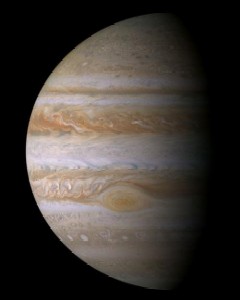The Planets - Jupiter
Updated May 8, 2019 |
Infoplease Staff



A belt of asteroids (fragments of rock and iron) between Mars and Jupiter separate the four inner planets from the five outer planets.
Jupiter, the largest planet in our solar system, was named for the most important Roman god because of its size. About 1,300 Earths would fit into it. Viewed through a large telescope, Jupiter is stunningly colorful—it is a disk covered with bands of blue, brown, pink, red, orange, and yellow. Its most distinguishing feature is “the Great Red Spot,” an intense windstorm larger in size than Earth, which has continued for centuries without any signs of dying down.
- Size: 11 times the diameter of Earth
- Diameter: 88,736 miles (142,800 km)
- Surface: A hot ball of gas and liquid
- Atmosphere: Whirling clouds of colored dust, hydrogen, helium, methane, water, and ammonia. The Great Red Spot is an intense windstorm larger than Earth.
- Temperature: –234°F (–148°C) average
- Rotation of its axis: 9 hours and 55 minutes
- Rotation around the Sun: 12 Earth years
- Your weight: If you weigh 100 pounds on Earth, you would weigh 265 pounds on Jupiter.
- Distance from Earth: At its closest, 370 million miles (591 million km)
- Mean Distance from Sun: 483.88 million miles (778.3 million km)
- Satellites: 63
- Rings: 4
Fact Monster/Information Please® Database, © 2007 Pearson Education, Inc. All rights reserved.
.com/science/astronomy/planet-jupiter.html







